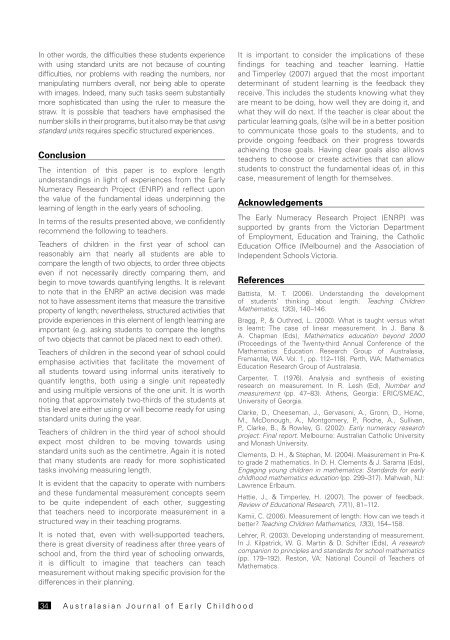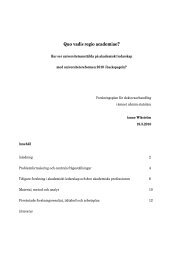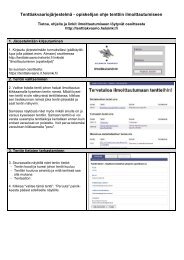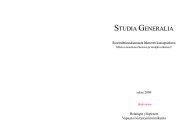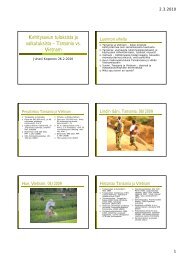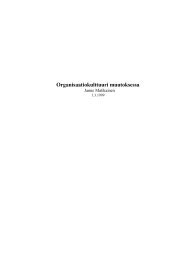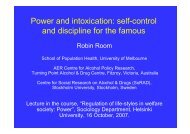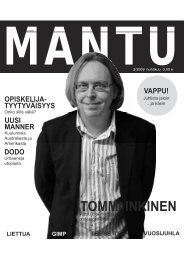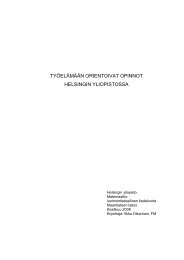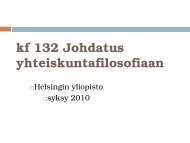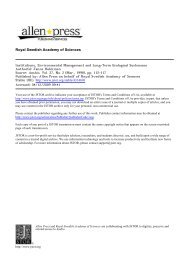Australasian Journal of Early Childhood
Australasian Journal of Early Childhood
Australasian Journal of Early Childhood
- No tags were found...
Create successful ePaper yourself
Turn your PDF publications into a flip-book with our unique Google optimized e-Paper software.
In other words, the difficulties these students experiencewith using standard units are not because <strong>of</strong> countingdifficulties, nor problems with reading the numbers, normanipulating numbers overall, nor being able to operatewith images. Indeed, many such tasks seem substantiallymore sophisticated than using the ruler to measure thestraw. It is possible that teachers have emphasised thenumber skills in their programs, but it also may be that usingstandard units requires specific structured experiences.ConclusionThe intention <strong>of</strong> this paper is to explore lengthunderstandings in light <strong>of</strong> experiences from the <strong>Early</strong>Numeracy Research Project (ENRP) and reflect uponthe value <strong>of</strong> the fundamental ideas underpinning thelearning <strong>of</strong> length in the early years <strong>of</strong> schooling.In terms <strong>of</strong> the results presented above, we confidentlyrecommend the following to teachers.Teachers <strong>of</strong> children in the first year <strong>of</strong> school canreasonably aim that nearly all students are able tocompare the length <strong>of</strong> two objects, to order three objectseven if not necessarily directly comparing them, andbegin to move towards quantifying lengths. It is relevantto note that in the ENRP an active decision was madenot to have assessment items that measure the transitiveproperty <strong>of</strong> length; nevertheless, structured activities thatprovide experiences in this element <strong>of</strong> length learning areimportant (e.g. asking students to compare the lengths<strong>of</strong> two objects that cannot be placed next to each other).Teachers <strong>of</strong> children in the second year <strong>of</strong> school couldemphasise activities that facilitate the movement <strong>of</strong>all students toward using informal units iteratively toquantify lengths, both using a single unit repeatedlyand using multiple versions <strong>of</strong> the one unit. It is worthnoting that approximately two-thirds <strong>of</strong> the students atthis level are either using or will become ready for usingstandard units during the year.Teachers <strong>of</strong> children in the third year <strong>of</strong> school shouldexpect most children to be moving towards usingstandard units such as the centimetre. Again it is notedthat many students are ready for more sophisticatedtasks involving measuring length.It is evident that the capacity to operate with numbersand these fundamental measurement concepts seemto be quite independent <strong>of</strong> each other, suggestingthat teachers need to incorporate measurement in astructured way in their teaching programs.It is noted that, even with well-supported teachers,there is great diversity <strong>of</strong> readiness after three years <strong>of</strong>school and, from the third year <strong>of</strong> schooling onwards,it is difficult to imagine that teachers can teachmeasurement without making specific provision for thedifferences in their planning.It is important to consider the implications <strong>of</strong> thesefindings for teaching and teacher learning. Hattieand Timperley (2007) argued that the most importantdeterminant <strong>of</strong> student learning is the feedback theyreceive. This includes the students knowing what theyare meant to be doing, how well they are doing it, andwhat they will do next. If the teacher is clear about theparticular learning goals, (s)he will be in a better positionto communicate those goals to the students, and toprovide ongoing feedback on their progress towardsachieving those goals. Having clear goals also allowsteachers to choose or create activities that can allowstudents to construct the fundamental ideas <strong>of</strong>, in thiscase, measurement <strong>of</strong> length for themselves.AcknowledgementsThe <strong>Early</strong> Numeracy Research Project (ENRP) wassupported by grants from the Victorian Department<strong>of</strong> Employment, Education and Training, the CatholicEducation Office (Melbourne) and the Association <strong>of</strong>Independent Schools Victoria.ReferencesBattista, M. T. (2006). Understanding the development<strong>of</strong> students’ thinking about length. Teaching ChildrenMathematics, 13(3), 140–146.Bragg, P., & Outhred, L. (2000). What is taught versus whatis learnt: The case <strong>of</strong> linear measurement. In J. Bana &A. Chapman (Eds), Mathematics education beyond 2000(Proceedings <strong>of</strong> the Twenty-third Annual Conference <strong>of</strong> theMathematics Education Research Group <strong>of</strong> Australasia,Fremantle, WA. Vol. 1, pp. 112–118). Perth, WA: MathematicsEducation Research Group <strong>of</strong> Australasia.Carpenter, T. (1976). Analysis and synthesis <strong>of</strong> existingresearch on measurement. In R. Lesh (Ed), Number andmeasurement (pp. 47–83). Athens, Georgia: ERIC/SMEAC,University <strong>of</strong> Georgia.Clarke, D., Cheeseman, J., Gervasoni, A., Gronn, D., Horne,M., McDonough, A., Montgomery, P., Roche, A., Sullivan,P., Clarke, B., & Rowley, G. (2002). <strong>Early</strong> numeracy researchproject: Final report. Melbourne: Australian Catholic Universityand Monash University.Clements, D. H., & Stephan, M. (2004). Measurement in Pre-Kto grade 2 mathematics. In D. H. Clements & J. Sarama (Eds),Engaging young children in mathematics: Standards for earlychildhood mathematics education (pp. 299–317). Mahwah, NJ:Lawrence Erlbaum.Hattie, J., & Timperley, H. (2007). The power <strong>of</strong> feedback.Review <strong>of</strong> Educational Research, 77(1), 81–112.Kamii, C. (2006). Measurement <strong>of</strong> length: How can we teach itbetter? Teaching Children Mathematics, 13(3), 154–158.Lehrer, R. (2003). Developing understanding <strong>of</strong> measurement.In J. Kilpatrick, W. G. Martin & D. Schifter (Eds), A researchcompanion to principles and standards for school mathematics(pp. 179–192). Reston, VA: National Council <strong>of</strong> Teachers <strong>of</strong>Mathematics.34A u s t r a l a s i a n J o u r n a l o f E a r l y C h i l d h o o d


